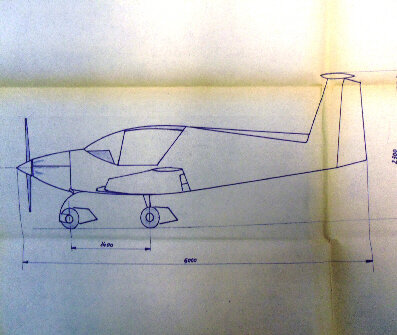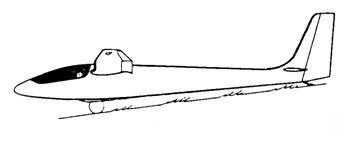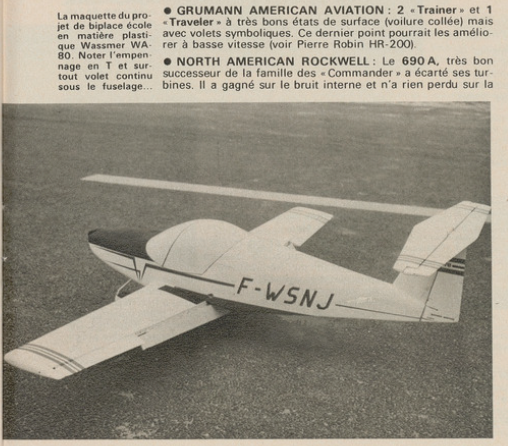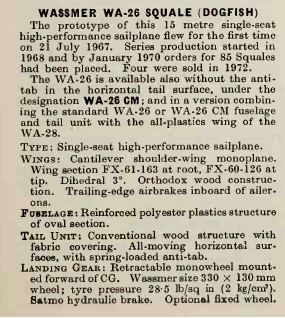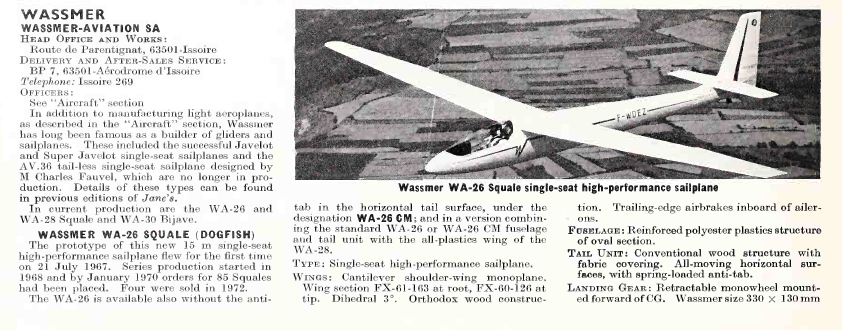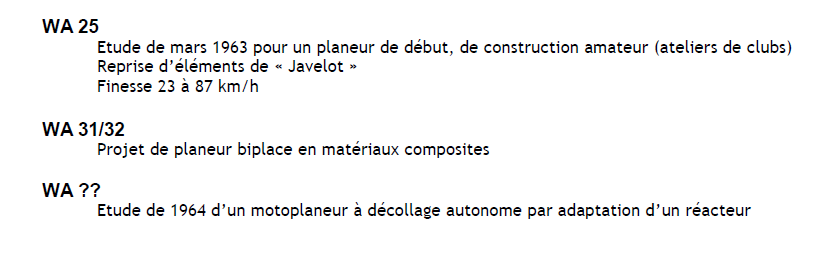- Joined
- 26 May 2006
- Messages
- 32,647
- Reaction score
- 11,839
Hi,
Benjamin Wassmer formed Societe Wassmer in 1905,a French
specialized woodworking company formed by Bernard Wassmer
in 1905. It later became an aircraft manufacturer specializing in
gliders. It was bought out by Issoire Aviation, a subsidiary of
Siren, in 1978.
Aircraft List;
Wa.10 speculative design,maybe a glider
Wa.20 Javelot I was a single seat glider
Wa.21 Javelot II was a single seat glider,a modified version of Wa.20
Wa.22 Super Javelot was a single seat glider,improved version of Wa.20
Wa.23 was a single seat glider,an experimental version of Wa.22
Wa.24 was a single seat glider Project,developed from Wa.23 with
Rigid wing,Shutters "Lower lifters which decamber",Monobloc tail
and Retractable wheel
Wa.25 was a study of March 1963 for a beginner glider, of amateur construction (club workshops) Resumption of "Javelot" elements,Project
Wa.26 Squale was a single seat high performance glider
Wa.26 Squale M,CM,CM Marfa & P were a variants of it
Wa.27 ------?
Wa.28 Espadon Recognition that wooden-winged gliders were becoming outdated resulted
in a redesigned wing, aerodynamically the same as the WA 26 Squale
Wa.29 was a single seat glider Project of 1976
Wa.30 Bijave was a two-seat advanced training glider
Wa.31 & Wa.32 were a two-seater glider Projects in composite materials
Wa.33 ? was a study of a motor glider with autonomous take-off by adaptation of a reactor,Project
Wa.40 Super IV was a four-seat low-wing tourer airplane,with retractable tricycle u/c,
powered by one 180 hp lycoming O-360-A1A engine
Wa.40A Super IV was a developed version,with swept tail and lengthened nose,named Sancy
Wa.40B was the same as Wa.40 except for swept drift
Wa.41 Baladou was a simplified version with fixed undercarriage
Wa.4/21 Prestige was a more powerful version of the WA-40A with 250 hp Lycoming IO-540-C4B5 engine
Wa.41-250 was an alternate designation for the WA 4/21 production aircraft with a 250 hp engine
CE.43 Guépard was a derived from the WA4/21 the CE-43 was produced by CERVA
CE.44 Couguar was a derived from CE-43 'Guépard'
CE.45 Leopard was a derived from CE-43 'Guépard'
Wa.50 was a prototype with retractable landing gear, first flew 22 March 1966, one built, registration F-WNZZ,had a four-seat
Wa.51 Pacific was a production version first flown in 1969 with a 150 hp (112kW) Lycoming O-320-E2A engine
Wa.52 Europa was as Wa.51 with a 160hp (119kW) Lycoming IO-320-B1A engine
Wa.53 was proposed variant with a 125hp Lycoming engine,Project
Wa.54 Atlantic was a Wa.51 with refinements and a 180hp (134kW) Lycoming O-360-A1LD engine
Wa.60 ? was a study carried out around 1971, in collaboration
with Aérospatiale of a two-seater aircraft made of materials
composites.Without continuation this Project will be replaced
by an adaptation in two-seater formula of the cell of the Wa.51
Wa.70 was a side-by-side two-seat trainer low-wing monoplane Project,
had a T-tail and powered by one 90 hp engine,1974,led to develop Wa.80
Wa.80 Piranha was a two-seater low-wing trainer monoplane,with a 100 hp Rolls-Royce Continental O-200-A engine
Wa.81 Piranha was a Wa.80 fitted with an extra third rear seat
Wa.82 Piranha was a study carried out around 1976, based on the Wa.81 airframe equipped with a 108 hp engine,Project
Wa.83 Piranha was a three-seater plane in glass - polyester laminate produced on the basis of the Wa.81 airframe equipped with a 120 hp Cont. O-240 engine.
- To be continued
Benjamin Wassmer formed Societe Wassmer in 1905,a French
specialized woodworking company formed by Bernard Wassmer
in 1905. It later became an aircraft manufacturer specializing in
gliders. It was bought out by Issoire Aviation, a subsidiary of
Siren, in 1978.
Aircraft List;
Wa.10 speculative design,maybe a glider
Wa.20 Javelot I was a single seat glider
Wa.21 Javelot II was a single seat glider,a modified version of Wa.20
Wa.22 Super Javelot was a single seat glider,improved version of Wa.20
Wa.23 was a single seat glider,an experimental version of Wa.22
Wa.24 was a single seat glider Project,developed from Wa.23 with
Rigid wing,Shutters "Lower lifters which decamber",Monobloc tail
and Retractable wheel
Wa.25 was a study of March 1963 for a beginner glider, of amateur construction (club workshops) Resumption of "Javelot" elements,Project
Wa.26 Squale was a single seat high performance glider
Wa.26 Squale M,CM,CM Marfa & P were a variants of it
Wa.27 ------?
Wa.28 Espadon Recognition that wooden-winged gliders were becoming outdated resulted
in a redesigned wing, aerodynamically the same as the WA 26 Squale
Wa.29 was a single seat glider Project of 1976
Wa.30 Bijave was a two-seat advanced training glider
Wa.31 & Wa.32 were a two-seater glider Projects in composite materials
Wa.33 ? was a study of a motor glider with autonomous take-off by adaptation of a reactor,Project
Wa.40 Super IV was a four-seat low-wing tourer airplane,with retractable tricycle u/c,
powered by one 180 hp lycoming O-360-A1A engine
Wa.40A Super IV was a developed version,with swept tail and lengthened nose,named Sancy
Wa.40B was the same as Wa.40 except for swept drift
Wa.41 Baladou was a simplified version with fixed undercarriage
Wa.4/21 Prestige was a more powerful version of the WA-40A with 250 hp Lycoming IO-540-C4B5 engine
Wa.41-250 was an alternate designation for the WA 4/21 production aircraft with a 250 hp engine
CE.43 Guépard was a derived from the WA4/21 the CE-43 was produced by CERVA
CE.44 Couguar was a derived from CE-43 'Guépard'
CE.45 Leopard was a derived from CE-43 'Guépard'
Wa.50 was a prototype with retractable landing gear, first flew 22 March 1966, one built, registration F-WNZZ,had a four-seat
Wa.51 Pacific was a production version first flown in 1969 with a 150 hp (112kW) Lycoming O-320-E2A engine
Wa.52 Europa was as Wa.51 with a 160hp (119kW) Lycoming IO-320-B1A engine
Wa.53 was proposed variant with a 125hp Lycoming engine,Project
Wa.54 Atlantic was a Wa.51 with refinements and a 180hp (134kW) Lycoming O-360-A1LD engine
Wa.60 ? was a study carried out around 1971, in collaboration
with Aérospatiale of a two-seater aircraft made of materials
composites.Without continuation this Project will be replaced
by an adaptation in two-seater formula of the cell of the Wa.51
Wa.70 was a side-by-side two-seat trainer low-wing monoplane Project,
had a T-tail and powered by one 90 hp engine,1974,led to develop Wa.80
Wa.80 Piranha was a two-seater low-wing trainer monoplane,with a 100 hp Rolls-Royce Continental O-200-A engine
Wa.81 Piranha was a Wa.80 fitted with an extra third rear seat
Wa.82 Piranha was a study carried out around 1976, based on the Wa.81 airframe equipped with a 108 hp engine,Project
Wa.83 Piranha was a three-seater plane in glass - polyester laminate produced on the basis of the Wa.81 airframe equipped with a 120 hp Cont. O-240 engine.
- To be continued
Last edited:


